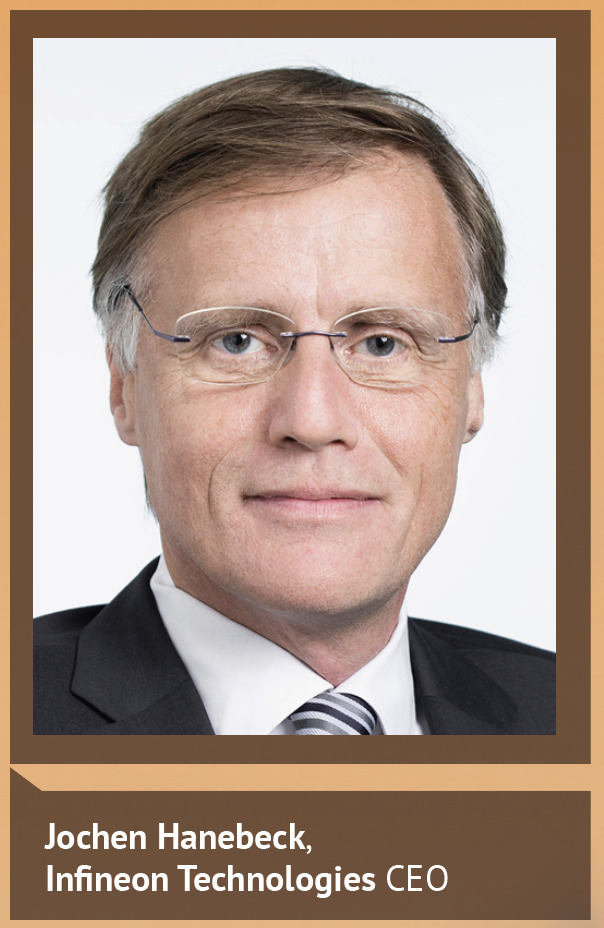 Electric vehicles are now at the center of efforts to reduce the impact of fossil fuel on the earth. Chipmakers have been charged with ensuring the achievement of this objective. Will they deliver?
Electric vehicles are now at the center of efforts to reduce the impact of fossil fuel on the earth. Chipmakers have been charged with ensuring the achievement of this objective. Will they deliver?
Power hogs are out. Electronic devices that sip—rather than guzzle—energy are in vogue.
And it is the job of semiconductor manufacturers to facilitate what is now universally accepted as an obligation by businesses and individuals to transition to energy-efficient and environmentally friendly devices.
The fate of the universe may be at stake. That, at least, is the way proponents of clean energy see it and many electronics industry executives agree with them. But even those who may have doubts or disagree can cite some good reasons why the development and sale of less power-hungry electronic equipment could be in everyone’s interest.
The clean-energy movement has been building for a while but 2023 will be a pivotal year. Governments, communities, enterprises, and individuals worry that geopolitical challenges are throttling efforts to reduce the impact of global warming on the earth and are even more determined to accelerate the development and adoption of cleaner energies.
By forcing countries in Europe to confront their vulnerabilities to externally procured crude oil and natural gas, the Russia-Ukraine war reinforced the need to search for better and more efficient energy streams, especially those generated using natural resources. But problems related to the generation, storage, distribution, and consumption of energy persist, according to policy makers who see the electronics industry as key to resolving some of these challenges.
“To end the EU’s dependence on Russian fossil fuels and tackle the climate crisis, our energy system requires a deep transformation, in which digitalisation plays a central role,” said the European Union, in a policy paper. “In a context of high energy prices, accelerating the digitalisation of the energy sector is key to help consumers save on their bills. Smart buildings, smart meters and electric vehicles, Internet of Things devices, provide key information that allow us to monitor energy consumption, increase renewable integration, and reduce costs.”
Semiconductor suppliers and systems manufacturers are demonstrating both the willingness and the capabilities required to sort out the power supply challenges industries and families are facing. But they are handicapped by the growing number of equipment that need to be redesigned or modified for better energy consumption.
Guzzlers not wanted
Still, demand for more power efficient devices is roaring and disrupting the once staid energy market. Systems developers are asking for smaller, more resilient, and less power-hungry components. In response, chip manufacturers have been highlighting new and innovative components and collaborating with others to develop subsystems that meet OEM customers’ constantly changing needs.
The high-tech and electronics markets are expected to keep growing over the next decade despite geopolitical disturbances, inflationary pressures, and concerns about the general direction of the global economy. Most semiconductor sectors should remain vibrant through the 2030s, according to observers, but the power electronics segment is gaining greater attention because of growing community demand for better management of natural resources.
In October, the EU announced the re-establishment of its Smart Grids Task Force—renamed the Smart Energy Expert Group—to coordinate power management activities at member states. Digitalisation of data and services will be at the center of actions meant to improve power generation and usage within the EU, the regional body said.
This is where the high-tech sector comes in. Throughout the industry, component suppliers—both passive parts and semiconductors—are exploring growth opportunities and racing to deliver compelling products and designs to systems developers and their tier-1 suppliers. New alliances and partnerships have been formed by suppliers, in addition to the establishment of more fabs and other assembly plants aimed at boosting the supply of energy efficient systems.
Nowhere is this structural adjustment more evident than in the automotive industry. Electronic vehicles are rolling out by the hundreds of thousands across the world as manufacturers respond to energy management initiatives and consumer demand. In 2020, EVs accounted for less than 5 per cent of global auto sales but still grew 43 per cent, year-over-year, according to a report by Virta, a provider of EV charging platforms in Europe.
The explosive growth rate recorded in 2020—despite the negative impact of Covid-19 related restrictions on production and auto IC supply—foretells what lies ahead for the industry. Sales of EV in 2021 climbed to 6.6 million, doubling from the prior year. 2022 was expected to be another exceptional year for EVs, according to the International Energy Agency (IEA).
“The success of EVs is being driven by multiple factors,” the IEA said, in a report. “Sustained policy support is the main pillar. Public spending on subsidies and incentives for EVs nearly doubled in 2021 to nearly USD 30 billion. A growing number of countries have pledged to phase out internal combustion engines or have ambitious vehicle electrification targets for the coming decades.”
China is leading the adoption of EVs, and by extension the growth of the supporting supply chain. In 2021, Chinese buyers accounted for half of the growth in demand for EVs although European consumers in countries like Germany and Sweden were also ardent adopters. Emerging economies lag the Western sector in demand for EVs, the IEA said.
Still, “in the longer term, government and corporate efforts to electrify transport are providing a solid basis for further growth in EV sales,” notes the IEA. “Electrifying transport has multiple benefits. Russia’s invasion of Ukraine has brought the role of EVs in reducing oil demand to the fore. It is one of the 10 measures proposed by the IEA to cut oil use in the near term.”
Researchers say the transition from fossil fuels to cleaner or green energy has taken on a life of its own and has become irreversible. Climate change is forcing all companies, including those in the services industries, to play closer attention to their energy footprint. The desire for and shift to cleaner energy will prove beneficial overall to society, helping to tamp down on and mitigate the effects of global warming, they said.
The transition “will come at a cost,” though, said Laurens Swinkels and Peter van der Welle, of asset management firm and consultancy Robeco in a research report.
“Transitions are complex processes,” the Robeco analyst said. “Their outcome is the result of various powerful forces, including chaos and stabilisation, coming together in often unpredictable ways. In the context of the energy transition, we highlight that implementation of carbon taxes or a strong regulatory push towards renewables in a perhaps too tight a time frame is very likely leading to all sorts of adaptive behavior.”
Semiconductor manufacturers supplying chips to EV manufacturers are enjoying robust demand for their products. Simultaneously, though, many are caught in problematic supply chain situations, unable in many cases to meet surging demand from auto OEMs and tier-1 suppliers. While many segments of the chip market have recovered strongly from the recent shortages, for example, auto makers are still complaining of long lead-times for semiconductors, especially MCUs.
It is not that semiconductor vendors serving the sector are purposely sitting on inventory or tamping down on production. Many are running their fabs at or close to full production capacity but are still unable to meet demand. They are swiftly adding new fabs and signing procurement deals with raw material vendors to assure continuity of supply.
Infineon is one of those companies that is racing to meet current and future customer needs, according to executives at the Munich-based semiconductor company. The company sees opportunities ahead in the supply of wide band gap semiconductors such as silicon carbide and has added to facilities in Europe.
In November, Infineon announced it would invest in a new 300mm analog and mixed-signal power semiconductor fab at an existing location in Dresden. Although the $5 billion plan is “subject to adequate public funding,” as Infineon said, in a statement, it is only one in a growing number of power semiconductor projects chipmakers have recently announced.
Many of these are geared towards supporting the EV market as well as the need to reduce global warming.
“Semiconductor solutions from Infineon are addressing two of mankind’s most pressing challenges: the need to fight climate change and the desire to reap the benefits of digitalisation,” said Jochen Hanebeck, Infineon’s CEO, during a presentation to financial analysts. “Infineon is at the core of major growth drivers such as e-mobility, renewable energy, autonomous driving, data center and power supply, the IoT and many others.”
Like their German competitor, American chipmakers Onsemi and WolfSpeed are also adding fresh capacities to beef up their power semiconductor offerings. They both have their eyes, naturally, also on the surge in demand for electronic vehicles and the development of autonomous vehicles. The systems used in EVs, and AVs will improve driving and security and simultaneously support clean energy goals, according to Onsemi CEO Hassane El-Khoury.
“One of the primary drivers of increasing numbers of cameras for cars has been the efforts by traditional OEMs to match to ADAS and related safety features offered by the disruptors and the new EV models,” El-Khoury said, while presenting second quarter results. “We are seeing an increasing use of our image sensors to enable safety through the replacement of traditional mirrors by camera enabled digital mirrors. We secured a design win for a digital mirror that incorporates four cameras for the rear and outside use.”

